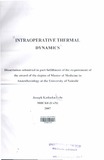| dc.contributor.author | Lelo, Joseph K | |
| dc.date.accessioned | 2013-05-25T09:14:55Z | |
| dc.date.available | 2013-05-25T09:14:55Z | |
| dc.date.issued | 2007 | |
| dc.identifier.citation | Degree of Master of Medicine in Anaesthesiology at the University of Nairobi | en |
| dc.identifier.uri | http://erepository.uonbi.ac.ke:8080/xmlui/handle/123456789/25626 | |
| dc.description | Dissertation submitted in part fulfillment of the requirement of
the award of the Degree of Master of Medicine in
Anaesthesiology at the University of Nairobi | en |
| dc.description.abstract | The role of anaesthesiologists is to maintain physiologic homeostasis during the
peri operative period, a time when alteration in body temperature is common. Anesthetics
create a state ofpoikilotherrnia in which body temperature tends to equilibrate with
ambient temperature. Nearly all patients under general anaesthesia become hypothermic,
typically by 1-3°e,1 depending on the type and dose of anesthetic. amount of surgical
exposure, 23. an d am bilent temperature. 2-4 r ;. •
Body temperature should be managed in a similar fashion as the other vital signs, with
efforts made to maintain normothermia.
An observational cross-sectional study was conducted at the Kcnyatta National Hospital
main theatre. In this study all patients over the age of 12 years undergoing general or
regional anaesthesia for orthopaedic procedures had their core temperatures measured
immediately pre-operatively. every 15 minutes intra-operatively and immediately postoperatively.
Ambient temperature within the operating room was measured and recorded
every 15 minutes intra-operatively. Amount of intravenous fluids and type of surgery
were also recorded with the raw data being captured on a standard questionnaire. ,
Perioperative hypothermia was found to be a common occurrence particularly
intraoperatively and postoperatively. Large amounts of intravenous fluids infused at room
temperature were also found to negatively impact on patients' core temperatures.
Relatively cool operating environments were found to also cause significlIlt lowering of
patients' core temperatures. 81% of patients in this study were found to be hypothermic
in the immediate postoperative period but only 45% reported actually feeling cold while
in the recovery room. | en |
| dc.language.iso | en | en |
| dc.publisher | University of Nairobi | en |
| dc.title | Intraoperative thermal dynamics | en |
| dc.type | Thesis | en |
| dc.description.department | a
Department of Psychiatry, University of Nairobi, ; bDepartment of Mental Health, School of Medicine,
Moi University, Eldoret, Kenya | |
| local.publisher | School of Medicine | en |

